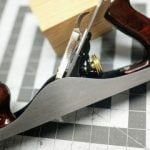What is the best way to remove rust from antique tools?
Welcome! / Forums / General Woodworking Discussions / Tools and Tool Maintenance/Restoration / What is the best way to remove rust from antique tools?
- This topic has 14 replies, 13 voices, and was last updated 7 years, 2 months ago by
morristh.
-
AuthorPosts
-
7 January 2017 at 2:42 am #143958
I bought a few antique tools, including a couple smoothing planes, and a saw. The saw has a black patina to it, which I was told is a normal oxidation of carbon steel.
One person suggested naval jelly, and another white vinegar. I saw paul’s video where he just sanded it off of a plane, but idk if that would be a good method for a saw.
Electrolysis is fine for many things, but not edged tools. It causes hydrogen embrittlement and will make edges brittle and easy to chip.
I have heard good things about Evaporust. A soak in vinegar works as well as cola. Wash immediately after soaking and coat with a light oil as the surfaces will be prone to surface rust.
If the discoloration is uniform and smooth, I would leave it alone. Old carbon steels can get a blued patina, this is similar to the blueing on a firearm. Once it has a uniform bluing, the oxidation stops. If it is scale rust or pitting, that is a different story.
-
This reply was modified 7 years, 3 months ago by
M W.
7 January 2017 at 6:59 am #143962Two other mild acids that work are citric acid and oxalic acid. I have also used Sulfamic acid, but it seems a bit too aggressive.
Sulfamic acid is found at Mason supply yards. Oxalic acid is often found at wood flooring supply places where it is used to bleach wood, and citric acid is found in pharmacies or at brewing and vintner supplies, it is used to clean vats. You should be able to get it for 5$-6$ a pound.
Citric acid is pretty benign for humans.
The other two- not so much.
With all of them, mix in a vat of water and submerge the tool. Check every few hours. Citric acid won’t harm rosewood, so you can just submerge a tool that the handles don’t come off like a Stanley 45 handles and all and it won’t hurt it.Finish up with fine (600 grit) emery paper or OOOO steel wool. For a high shine, use a metal polish to finish up.
Saw plates areusualllyquicker to sand. There are several tutorials online for saw plates which involve sanding with several grades of emery paper and a lubricant like light oil or Simple Green. With care, you can save the etching on the plate.
I picked up Disston #4 today for $3 and am working through cleaning the plate. I don’t know why. I have plenty of back saws, but I could tell it was a good saw and figured I could return it to circulation for somebody.

-
This reply was modified 7 years, 3 months ago by
Larry Geib.
-
This reply was modified 7 years, 3 months ago by
Larry Geib.
-
This reply was modified 7 years, 3 months ago by
Larry Geib.
-
This reply was modified 7 years, 3 months ago by
Larry Geib.
7 January 2017 at 7:14 am #143967I should have added that for Brass and light rust on steel, Barkeepers Friend will bring the metal to a nice shine.
It has oxalic acid as an ingredient.

Hi,
+1 for Citric Acid, it works really well. I used it on all my tool restoration projects.
Be aware though that it will strip even slightly loose paint. I recently soaked a plane body in Citric Acid (it was in very bad condition), and while it cleaned it up really well, it also removed loose black paint (not enamel) that a previous owner had sprayed on. That may or may not be what you want.
I’ve also tried Diet Coke baths. They work well, but it takes days. Citric Acid takes hours.
Regards
Darren.
7 January 2017 at 10:21 pm #143988Here’s the same 16″ saw I posted above after an hour’s sanding with 200 and 400 grit emery paper and Simple Green. I also used the diamond mesh foam block (shown) a tile setter friend of mine gave me after he deemed it worn out. It makes short work of the first stage of sanding, though it is not at all necessary. Reshaping and refinishing the handle, and polishing the saw nuts actually took longer.

Note that the etch is mostly intact after the sanding.And I included the little 8″ saw in the picture because is also is classed a #4 backsaw in Disston’s numbering system.
Go figure.
-
This reply was modified 7 years, 3 months ago by
Larry Geib.
-
This reply was modified 7 years, 3 months ago by
Larry Geib.

Good job on the saws. I have tried Naval Jelly on saws, but sandpaper seemed to be faster and less trouble. I finished them up with a Scotch Brite pad from the kitchen.
At present, I am soaking some frog nuts (from a Stanley #4C) in white vinegar to remove rust. We shall see how that goes.
I generally use electrolysis for bigger pieces like plane bodies and frogs and Evaporust for the small stuff.
Saws are different. I follow the approach that most of the pros seem to be using. Spray the plate down with Simple Green or a similar all-purpose cleaner. Then drag a razor blade blade, held at about a 45 degree angle, from the heel to the toe of the saw to remove the loose rust. Wipe it down, respray and switch to your choice of abrasives. (I use the fine sanding sponges from Harbor Freight.) Wipe it clean again. I’ll finish up By rubbing it down with a wad of aluminum foil charged with a fine paste-type polish. I use mag wheel polish but I’ve used auto body polishing (not rubbing) compound. Some guys swear by the very expensive metal polishes that come in toothpaste style tubes. (I wonder how toothpaste would work. I’ll try it next time.)
-
This reply was modified 7 years, 3 months ago by
Dave Ring.
 17 January 2017 at 3:13 pm #308444
17 January 2017 at 3:13 pm #308444It can be a bit messy, but WD40 and coarse steel wool will take care of most rust. Anything more stubborn gets 80 grit wet & dry abrasive paper, but I like the steel wool because it leaves any etching and hard edges intact where the paper can blur or round over.
20 January 2017 at 11:34 pm #308549The best way is what works for You.
Sanding does work for a saw.
I’ve had a saw blade with a black patina which when touch with sandpaper immediately gave off rusty dust. So be careful – not all patina are good patinas.
Be sure to share pix.
21 January 2017 at 12:12 am #308555Next time I restore a saw, I will definitely try citric acid. I have one quite old saw, that had a print on the side, which I almost sanded away. It might have happened with citric acid too, but perhaps not…
Dieter
I’ve used both citric and vinegar for my old disstons. I wanted off the fine rust though, I like the old patina. Overnight soak in vinegar or a few hrs in citric depending on its strength. All on how fast you want to do it. Oxalic is toxic, so be careful.
Heavy items I used electrolysis.
Ymmv
-
This reply was modified 7 years, 3 months ago by
-
AuthorPosts
- You must be logged in to reply to this topic.
